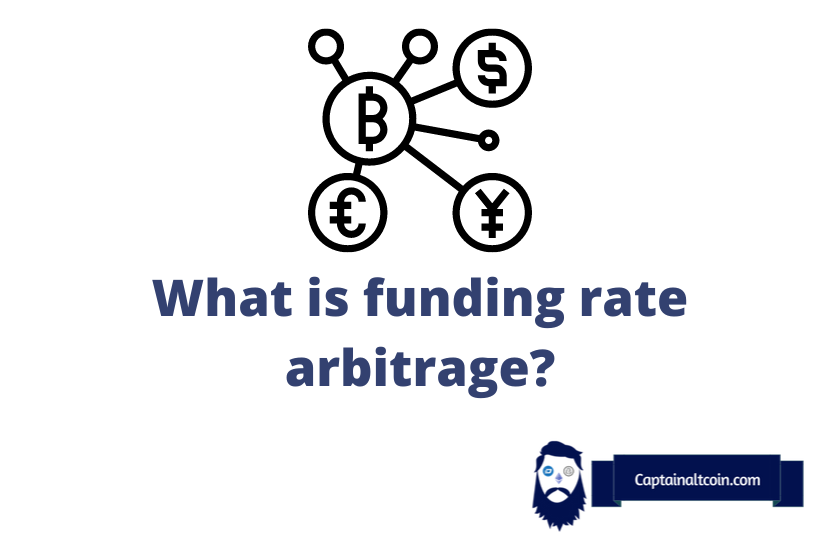
What you'll learn 👉
💰 Futures Funding Rate Arbitrage Guide
Futures Funding Rate Arbitrage is an increasingly popular way for cryptocurrency traders to profit from discrepancies in spot and derivatives prices. In this type of trading, the goal is to take advantage of different funding rates between various participants in the market.
By utilizing a positive funding rate, traders can potentially earn money from multi-users who are contract buyers by collecting fees. In contrast, on the flip side, traders have the ability to generate funds when utilizing a negative funding rate.
The process is simple: if the market is bullish and longs prevail, then the price of the perpetual contract will be higher than the spot price, and thus a positive funding rate will emerge – at this point, those holding short positions will receive fees from their multi-user counterparts. Conversely, when a negative funding rate arises (due to inevitable situations such as bearish markets), shorts must pay multiple sides for their ‘mistake’.
Understanding how Futures Funding Rate Arbitrage works is key to profiting from price discrepancies in cryptocurrency markets. By employing a well-thought-out strategy and having an eagle eye for potential opportunities, investors can capitalize on these discrepancies without taking on too much risk or losing out down the line.
Read our article on the best crypto bots that can arbitrate automatically. And our guide on the best crypto arbitrage scanners that scour the markets to find the price discrepancies for you to take advantage of.
💡 What is Futures Funding Rate Arbitrage?
Futures funding rate arbitrage allows traders to take advantage of and make a profit. Specifically, when a trader longs one futures market and shorts another, they can collect the difference in funding rates available within the exchange.

Smart traders can earn a significant return on their investments by taking advantage of the long-skewed funding rate on Perps. Futures funding rate arbitrage can be quite complex and involves considerable risk, so it’s important that the investor researches this type of venture before investing any money.
With proper knowledge and understanding of how this process works, there is potential to earn attractive returns through futures funding rate arbitrage.
🤑 Understanding Funding Rates: An Important Concept
Funding rates are an important concept that all traders using perpetual Futures need to understand. These rates help keep the price of derivatives in line with their underlying spot prices so that speculators can reliably utilize them for price movement predictions.
Funding rates will either incentivize or discourage traders, depending on the difference between the derivatives’ price and its underlying assets’ – if the former is higher, then longs will pay shorts, and vice versa.
With these unique mechanics in mind, there is great potential for arbitrage of funding rate differences between synthetic futures platforms such as Kwenta and other similar derivatives exchanges. Knowing what to look out for and how to capitalize on this arbitrage opportunity can give traders a considerable edge in the market. So master your understanding of funding rates, and you’ll soon be able to reap the rewards!
👍 Benefits of Funding Rate Arbitrage for Traders
Funding Rate Arbitrage offers several benefits for traders, allowing them to potentially enjoy higher returns and lower risk.
Firstly, regarding yield farming and staking on ETH/BTC/etc., returns tend to be pretty low (1-6%). However, with funding rate arbitrage, you can amplify those returns through leveraging and get 20% or more yields.
Secondly, if you go long and short on the same position, you’re effectively hedged against the rest of the market. It’s important to remember that there are still risks associated with this strategy as any kind of leverage trading carries liquidation risk, protocol penalty risks and oracle risks.
Finally, engaging in trading activities related to funding rate arbitrage is also beneficial for the protocol as traders collect interest from their positions (known as ‘funding’). This helps bring down debt pool risks while also giving other traders a lower rate of funding.
💸 Funding Rates Arbitrage Opportunity – A Current Example
The current market provides a great opportunity for funding rate arbitrage on the LUNA2 Perpetual Contract. According to historical data of the Bybit Perpetual contract funding rate, it has been positive and in the high end for an extended period of time. This means investors can take advantage of this by holding a short position in LUNA2 and collecting capital fee income.
However, investors must be aware that there is still risk associated with this strategy when considering coin price fluctuations. If the price of LUNA2 rises beyond expectations, then investors would face losses on their current positions. To hedge against this risk, it is advised that investors buy an equivalent LUNA2 Spot or hold a long position in the margin market with an equivalent amount of their short position in LUNA2 (buydown).
By taking advantage of funding rate arbitrage opportunities like this and mitigating risks with spot/margin strategies, investors can make profitable trades while also reducing exposure to market volatility.
🔒 Cash and Carry – Funding Rate Arbitrage Explained
Cash and Carry – Funding Rate Arbitrage is a trading strategy designed to exploit mispricing between an underlying asset and its associated derivative. In simple terms, it works like this: you take a position in the derivative contract that tracks the performance of the underlying asset, and at the same time, you also take on a spot position in the underlying asset.
For example, if we consider ETH futures and ETH spot as our derivatives/underlying assets, then one could perform Cash and Carry Funding Rate Arbitrage by taking a long position in the futures while simultaneously taking a short position in spot ETH. With this strategy, traders can lock in profits from the misperceived value between the two products.
Thanks to blog.synthetix.io for providing insight into this complex financial trading technique!
📈 Understanding Cash-and-Carry Trades and their Benefits
Cash-and-Carry Trades allow investors to take advantage of market pricing discrepancies. This is achieved by taking a long position in a security or commodity and simultaneously selling the associated futures derivative.

An example of this is when an investor purchases the spot version of the asset, but shorts its Synthetix Perpetual Future. Doing so allows them to collect the funding rate if the market is long-skewed and shorters are currently being paid to short.
Cash-and-carry trades benefit from its ability to capture yield from profitable trading opportunities in otherwise highly competitive markets. This strategy also helps reduce risk since the trader has more control over their returns compared to other investment strategies.
It can also help investors maximize their profits since the spread and funding rate are factored into their final return on capital in cash-and-carry trades.
💰 Cash and Carry – A Current Example
Cash and carry is one of the most popular strategies for funding rate arbitrage, and it can be used to great advantage when the funding rate is positive. By shorting the asset on an exchange and then buying the same amount to hedge against price fluctuations, traders can reap a potentially high profit.
The way cash and carry works are simple – you short a position on a derivatives exchange (it can be done on DEXes that allow derivative trading), and whatever profits you reap from that can be partially withdrawn in order to purchase the same asset in a spot trade. This way, your trade is hedged against major price movements and you make sure you don’t take too much risk or over-leveraging yourself.
With this strategy, you could rake in an impressive 45.56% return net of any fees involved – however, bear in mind that this approach requires more capital upfront than if you were using leverage for your spot trade instead.
Perpetual Contract Funding Rate — Margin Arbitrage
Perpetual contract funding rate Margin Arbitrage is a great strategy to understand when trading margin products. The funding rate of a perpetual contract is determined by the difference between a floating rate and fixed rate.
On Bybit, users can also take advantage of their tier-rate system which provides lower transaction fees and lending rates as your account level increases. Taking this into account along with one’s transaction costings can help develop an effective and profitable funding rate arbitrage strategy!
⚠️ Risk Warning: Important Considerations
⚠️ Risk Warning: When engaging in funding rate arbitrage, traders must know the potential risks involved. To minimize losses due to price fluctuations, it is important to reduce margin levels. Moreover, when choosing currencies for this strategy, make sure you do your research and choose currencies with high rates and long durations.
It is also important to invest a reasonable amount of capital to limit your trading risk – investing large amounts of money in small-cap currencies may result in high levels of slippage and high transaction fees. Lastly, frequent trading between coins should be avoided as this will make it difficult to turn a profit.







